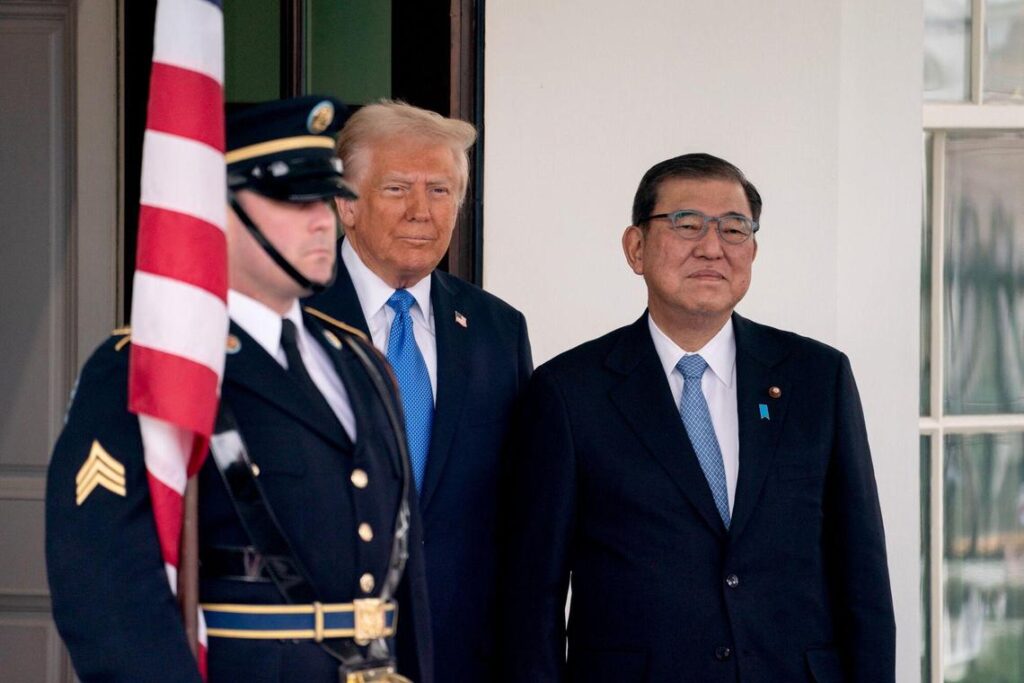TOKYO – Japan has initiated discussions with teh United States to gather information on President Donald Trump’s proposed reciprocal tariff initiatives, as it prepares for potential economic implications.
On February 14, Japanese Trade Minister Yoji muto and Chief Cabinet Secretary Yoshimasa Hayashi informed reporters that Tokyo has started dialogues with Washington regarding this issue, following Mr. Trump’s directive for his administration to explore imposing reciprocal tariffs on various trading partners.
Mr. Trump has specifically identified Japan and South Korea as countries he perceives as benefitting at the expense of the US, according to a statement from a White House official. Historically, Mr. Trump has criticized Japan’s trade surplus with the US and the yen’s depreciation contributing to this disparity.
This round of scrutiny by Mr. Trump targets nations that enforce tariffs exceeding those of the US while also considering non-tariff obstacles imposed by these nations on American imports—such as unfair subsidies, regulatory measures, value-added taxes, currency manipulation, and other elements detailed in a White House memorandum.
For Japan’s economy—which is projected to experience slight contraction in 2024—the prospect of new tariffs from the US poses important challenges for Prime Minister Shigeru Ishiba as he seeks to stabilize support for his minority government amidst increasing economic pressures.
When questioned about whether Japan’s tariff rates surpass those of the US and how non-tariff measures might affect trade relations, Mr. Muto offered a broad response without addressing specifics directly. “We need clarity on this matter promptly; we will start by understanding how the US views these issues,” Muto stated. “Our aim is to react suitably so that we can continue strengthening our economic ties with the US while aligning with our national interests.”
estimates indicate that Japan’s tariff rates currently exceed those applied by the US—a factor that might render Tokyo vulnerable to Mr. Trump’s actions. By 2025, average Japanese tariffs on imports from America are predicted to be around 3.2%, compared to only 1.4% levied by American authorities on goods imported from Japan according professor Kenichi Kawasaki at tokyo’s National Graduate Institute for Policy Studies.
Professor Kawasaki opined that it may be strategically beneficial for Mr.trump to focus efforts on reducing Japanese tariffs instead of increasing American ones since “Japan exports minimal agricultural products,” meaning even if levies rise significantly it would not bolster agricultural output domestically in America.”
In terms of food trade alone in 2024,projections reveal that Japan exported ¥213 billion (S$1.88 billion) worth of products such as fruits and vegetables into America—a mere one percent share of it’s total exports—to which it imported ¥1.8 trillion worth (a staggering 14 percent share) back from its trading partner.
The Complex Dynamics Between Tariffs
Underlying tensions surrounding tariff adjustments mask a cordial rapport between Prime Minister ishiba and President Trump nurtured during their initial face-to-face discussion earlier in February where no explicit threats concerning tariffs were announced post-meeting.
Efforts Made Towards Tariff Exemptions
Recently diplomacy exchanged hands when Tokyo requested an exemption for Japanese companies regarding Trump’s fresh implementation aimed at applying a hefty 25 percent duty targeting steel and aluminum shipments effective March 12th..
The Automotive Sector at Risk
Should any additional duties be placed upon Japanese automotive exports destined for america; this would significantly impact key players within an industry already sensitive towards shifts within trade policy—especially given many established automakers run operations across Mexico and Canada amidst current uncertainties concerning potential repercussions faced there too due stalled negotiations over proposed American levies affecting both regions .” p>
As regards vehicles specifically , analysts note concerns long-held about barriers associated with sectors like inspections faced when entering into japanese markets have hampered growth opportunities comparable found legitimate pathway available elsewhere ; enumerated quite forwardly prior past experiences capitalizing aside limited overall influxes via competitors looking down same avenue previously proclaimed antagonistic difficulty growth models upon seeking durable solutions rather than revert backwards introduced initially through stricter polices altogether . p >
In summation , automobiles & components constituted crucial undercurrents alongside one-third entire circulation largely directed toward exportation handled across Atlantic pursuing closures thereby limiting access comparatively reached merely approximately barely approximating low marks attained last subset inquiry dropping present shares visible against reverse trends dictated externally knowing insufficiencies contrasted situational depictions seen presently infused nationwide outlooks ! ” p >
Keep up-to-date! Join ST’s Telegram channel today! p >
